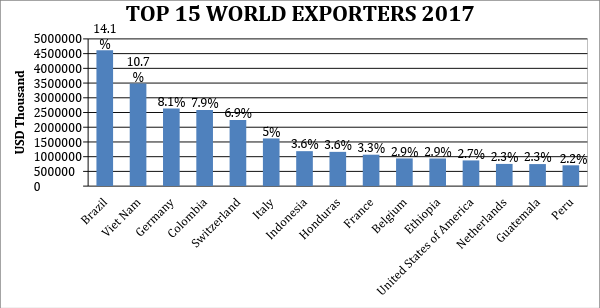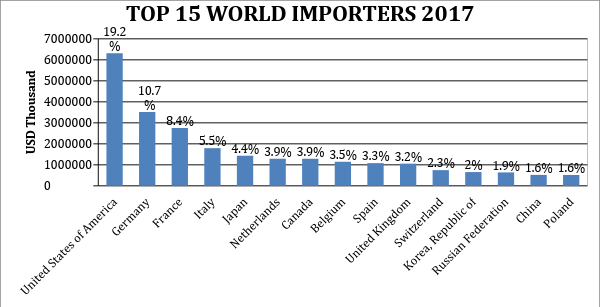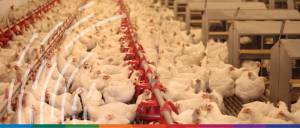According to the FAO’s (Food and Agriculture of the United Nations) latest available data, in coffee was in the top 20 export value commodities in the world in 2016. However, the coffee world is continuing to evolve and provide new market opportunities.
Based on the 2018/2019 Forecast of United States Department of Agriculture, world coffee production will be higher than the previous year, mainly due to the Brazilian output record, linked with global consumption growth and strong demand.
For this reason, new consumptions trends, for instance, “third wave coffee” are appearing and changing the traditional coffee trade.
Macro analysis of the coffee world trade situation
To understand the current trade situation, participants (exporters and importers) must research and be up to date on both a general and a specific vision of the market.
The most important coffee HS (harmonic system) will help to describe the real status of different aspects of the trade:
- HS 0901: Coffee, whether or not roasted or decaffeinated; coffee husks and skins; coffee substitutes
- HS 090111: Coffee (excluding roasted and decaffeinated)
- HS 090121 Coffee Roasted coffee (excluding decaffeinated)
HS 0901 EXPORTS

Source: Trademap
In this bar chart of the 15 main exporters in the world in 2017, it must be distinguished between coffee producers such as Brazil, Vietnam, and Colombia, and buyers and re-exporters such as Germany, Italy, and France.
We can see how Brazil, Vietnam and Colombia keep the first positions as the principal producers and exporters since 2013 (trademap data) and the importance of other Asian countries (Indonesia), Africa (Ethiopia) and Central America (Honduras and Guatemala).
Taking the example of Germany as the most important buyer and re-exporter, the following chart explains how these countries are adding value to green coffee and then re-exporting mainly to the rest of Europe.
| TOTAL (HS 0901) | HS 090121 | HS 090111 | HS 090112 | HS 090122 | HS 090190 | |||||||
| Year 2017 | VALUE | VALUE | VALUE | % | VALUE | % | VALUE | % | VALUE | % | VALUE | % |
| Import | 3.514.860 | |||||||||||
| Re-Export | 2.639.806 | 1.438.086 | 54% | 621.837 | 24% | 531.666 | 20% | 47.697 | 2% | 520 | 0,02% | |
Source: Trademap Value: Thousand USD
One of the most significant pieces of data is the 75% of Germany´s imports that are re-exported, with the remaining 25% are for internal consumption.
Taking the total re-exporting value (USD thousand 2.639.806), 54% belongs to Roasted coffee (excluding decaffeinated), followed by 24% of Coffee (excluding roasted and decaffeinated).
This shows that these countries are more focused on adding value and re-exporting.
Switzerland is another clear example, reaching in 2017 USD 2,249,770K of total export value, of which 91% was HS 090121 Roasted coffee (excluding decaffeinated).
HS 0901 IMPORTS

This bar chart represents the 15 most important importers in 2017 with the USA taking the highest percentage of total global imports at 19.2. In this case, Germany (10,7%), France (8,4%) and Italy (5,5%) appear again because as we saw in the export research, these are very important re-exporting and non – producing countries.
According to Trademap trade indicators, annual average growth in value was 3% between 2013 – 2017, and between 2016 – 2017, growth reached 10%.
Countries such as the Netherlands, Hong Kong, Saudi Arabia, and Turkey, with an Annual growth between 2016 – 2017% of: 39%, 106%, 35% and 47% respectively, must be analyzed carefully as potential import markets.
What is the future for countries producing high-quality coffee?
Linked with very strong international demand and supported by The National Coffee Association (NCA) report on American coffee consumption in 2017 on national coffee drinking trends, 59% of coffee consumed daily in America is classified as “gourmet”.
This specialty coffee is characterized by direct relationships with coffee farmers, as a way to reward their efforts, fair pricing and traceability, while ensuring the highest quality from the origin to the final consumer.
For this reason, there appear new market opportunities for countries like: Colombia, Costa Rica; and Ethiopia. These countries produce high quality coffee, receiving the opportunity to add value, for example toasting, packaging, and exporting directly through international importers, achieving fair sales conditions.
Colombian companies from Nariño such as La Maria Cafes Especiales, La Catedral and KRK Caffeto, are very significant examples of this new market trend. They are developing their own marketing strategies and starting to deal with international markets, ensuring the Nariño coffee essence.





























